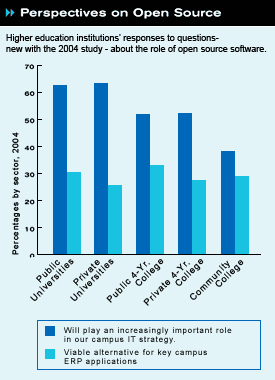Open Source: Affirmative Ambivalence?
Will open source thrive in higher education? Campus Computing 2004 looks
for an answer.
Open source has recently received a lot of attention in higher education technology
circles, especially with the release of the Sakai open source CMS and the announcement
of the Kuali Project’s intention to produce an open source financial system.
But beyond the core group of developer schools, how do institutions perceive
the open source movement?
The 2004 Campus Computing survey asked 516 participating schools to indicate
whether open source will play an increasingly important role in their IT strategy,
and whether they felt open source could be a viable alternative for ERP systems.
Though a higher percentage of institutions indicated that open source software
would play an increasingly important strategic role, perhaps it’s more
interesting that nearly 30 percent of respondents said that open source would
be a viable alternative for key campus ERP applications—this with the
Kuali Project virtually just announced.
“We get a very interesting portrait in terms of attitudes towards open
source,” says Casey Green, founder of the Campus Computing Project. “I
would characterize it as affirmative ambivalence. I think we are seeing a statement
that open source is going to be an important part of the landscape for our institutions
over the next two to three years…but we have some very strong advocates,
we have some very strong antagonists, and we have many agnostics in the middle.”
Green g'es on to say that it might be more interesting to consider whether
open source applications will make the transition from the back room to become
branded, day-to-day products—open source CMS, student information systems,
ePortfolio systems, financial systems, or other key applications for our institutions.
He reports that there still is a “huge level of uncertainty,” but
indicates that it is understandable, considering where the open source products
are in their development cycle. In the end, open source must pass the test of
the marketplace, as d'es any other product or technology. Over time, as open
source comes to campuses, we’ll know whether or not it will thrive.
